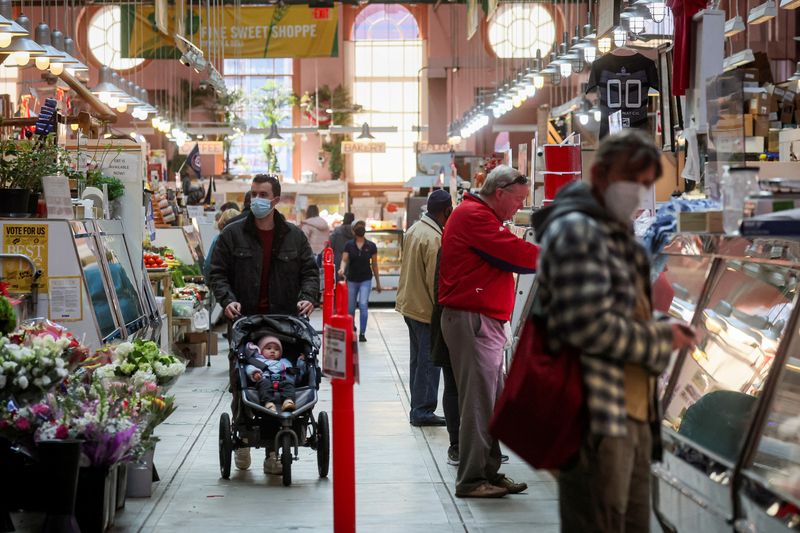U.S. consumer spending rebounds, but high inflation cooling demand
2022.10.02 21:49
[ad_1]

© Reuters. People shop at the Eastern Market in Washington, U.S., February 11, 2022. REUTERS/Brendan McDermid
By Lucia Mutikani
WASHINGTON (Reuters) – U.S. consumer spending increased more than expected in August, but stubbornly high inflation is dampening demand, potentially limiting an anticipated rebound in economic growth this quarter.
The report from the Commerce Department on Friday also showed underlying inflation pressures building up last month, providing cover for the Federal Reserve to remain on its aggressive monetary policy tightening path.
Wage growth also appears to be slowing and consumers are tapping excess savings to offset high prices. That, combined with stiff interest rate hikes from the Fed, has increased the economy’s vulnerability to a recession next year.
“More pain lies ahead as the economy heads toward a moderate downturn in the first half of next year,” said Sal Guatieri, a senior economist at BMO Capital Markets in Toronto. “This will eventually cool inflation, but not before the Fed takes a few more swings at the tightening can.”
Consumer spending, which accounts for more than two-thirds of U.S. economic activity, increased 0.4% last month after falling 0.2% in July. Economists polled by Reuters had forecast consumer spending rising 0.2%.
Revisions to the data from 2017 showed consumer spending was a bit stronger than previously thought and the level of savings was lower. Some of the increase in spending last month reflected higher prices, especially for housing and utilities.
Spending was led by services, where outlays surged 0.8% after edging up 0.1% in July. There were also increases in spending on transportation services, healthcare as well as dining out, hotel and motel accommodation.
But outlays on recreational services fell, a sign that consumers were cutting back on discretionary spending.
Spending on goods dropped 0.5%, held down by a decrease in receipts at gasoline service stations amid lower gasoline prices. Goods spending fell 0.7% in July. There were also declines in spending on recreational goods, another indication consumers were pulling back on discretionary spending. Outlays on furniture and other long-lasting manufactured goods fell.
But spending on motor vehicles rose. Overall, spending is rotating back to services from goods.
Gasoline prices dropped 11.8% to $3.691 per gallon in August from July, according to data from the U.S. Energy Information Administration. That, however, offered little relief on the inflation front last month, with services prices rising 0.6%.
The personal consumption expenditures (PCE) price index gained 0.3% after dipping 0.1% in July. In the 12 months through August, the PCE price index increased 6.2% after advancing 6.4% in July. Excluding the volatile food and energy components, the PCE price index jumped 0.6% after being unchanged in July. The so-called core PCE price index climbed 4.9% on a year-on-year basis in August after increasing 4.7% in July.
The Fed tracks the PCE price indexes for its 2% inflation target. Other inflation measures are running much higher. The consumer price index increased 8.3% year-on-year in August.
Stocks on Wall Street were mixed. The dollar rose against a basket of currencies. U.S. Treasury yields fell.
WAGE GROWTH SLOWING
Inflation has, however, likely peaked. A separate report on Friday showed the University of Michigan survey’s one-year consumer inflation expectations slipped to a reading of 4.7% in September. That was the lowest since September 2021 and down from 4.8% in August. The survey’s five-year inflation outlook fell to 2.7% from 2.9% in August, dropping below the 2.9%-3.1% range for the first time since July 2021.
The Fed last week raised its policy interest rate by 75 basis points, its third straight increase of that size, and signaled more large increases to come this year.
Since March, the U.S. central bank has hiked its policy rate from near zero to the current range of 3.00% to 3.25%. Last week, the Fed raised its median forecast for core PCE inflation to 4.5% this year from its previous estimate of 4.3% in June. Its estimate for core inflation in 2023 was boosted to 3.1% from the previously projected 2.7% in June.
High inflation is cutting into spending. Inflation-adjusted consumer spending edged up 0.1% in August after dipping 0.1% in the prior month. That suggests consumer spending could be tepid this quarter after helping to blunt the drag on gross domestic product from a slowdown in the pace of inventory accumulation in the second quarter.
Consumer spending increased at a 2% annualized rate in the second quarter. The economy contracted at a 0.6% pace last quarter after shrinking at a 1.6% rate in the January-March quarter. Goldman Sachs (NYSE:) cut its third-quarter GDP growth forecast by 0.5 percentage point to a 0.9% rate on the spending data.
Growth this quarter is seen driven largely by a narrowing trade deficit. An accumulation of inventory, part of it unsold goods because of slowing demand, is also seen supporting GDP growth this quarter.
“The near-term outlook remains modest at best,” said Scott Hoyt, senior economist at Moody’s (NYSE:) Analytics in West Chester, Pennsylvania. “Rising interest rates will make new borrowing more expensive, undermining spending on big-ticket items typically bought on credit.”
Consumer spending is likely to remain moderate, with wage growth showing signs of slowing. Personal income rose 0.3% in August, matching the prior month’s gain.
Wages increased 0.3% after surging 0.8% in July. The saving rate was unchanged at 3.5%. July’s saving rate was slashed to 3.5% from the previously reported 5.0%. The saving rate was as high as 26.3% in March 2021. It is now near levels seen during the 2007-09 Great Recession.
“It looks like consumers have been eating into the ‘excess saving’ built up over the earlier stages of the pandemic to fuel recent spending,” said Daniel Silver, an economist at JPMorgan (NYSE:) in New York.
[ad_2]
Source link








